Camponotus hyatti
| Camponotus hyatti | |
|---|---|

| |
| Scientific classification | |
| Kingdom: | Animalia |
| Phylum: | Arthropoda |
| Class: | Insecta |
| Order: | Hymenoptera |
| Family: | Formicidae |
| Subfamily: | Formicinae |
| Tribe: | Camponotini |
| Genus: | Camponotus |
| Species: | C. hyatti |
| Binomial name | |
| Camponotus hyatti Emery, 1893 | |
| Synonyms | |
| |
Camponotus hyatti is a highly polymoprhic species with majors, medias and minors. It is found nesting inside wood, including oaks, manzanita, chemise, sagebrush, and inside the hollow base of thick shrubs including Yucca and Ephedra. Workers forage during the day. Nest size can be more than 200 workers. Reproductives fly during the summer rains. Males and reproductive females can be found in nests as late as early August on the Colorado Plateau. There is a single reproductive queen in the nest.
Photo Gallery
Identification
This species is a member of the subgenus Myrmentoma, a Holarctic group of small to medium sized carpenter ants. There is a distinct notch in the middle of the anterior margin of the clypeus in this subgenus which has about 13 North American species. Camponotus hyatti also has sparsely punctate 5-toothed mandibles, and a flattened, shiny sparsely punctate clypeus in major workers and the female reproductives. In the major workers, the entire frontal and malar area of the head is smooth and shiny. There is a distinct metanotal groove. The basal face of the propodeum is convex in profile rather than flat. There are only a few erect hairs on the dorsum of the pronotum and mesonotum.
Mackay and Mackay (2002) - The majors of this species can be recognized by the deep impression at the metanotal suture, and by the convex dorsal face and concave posterior face of the propodeum. They are generally bicolored, with the head and mesosoma reddish-brown, and the gaster dark brown. The antennal scapes fail to reach the posterior lateral corners by about 2 funicular segments. The petiole is slender as seen in profile. The majors have few erect hairs, with none on the sides of the head, on the cheeks, or on the scapes. The dorsal and posterior faces of the propodeum are about equal in length. There are usually few erect hairs on the dorsum of the mesosoma, on the petiole, and dorsum of the gaster. Most surfaces are at least moderately shining, the gaster is transversely striolate and shining. The area between the punctures on the mandibles and the dorsum of the gaster are smooth and shining. The minors are similar, with the metanotal suture impressed on the dorsum of the mesosoma, but not as deeply as in the major worker. The pilosity, sculpture, and color are similar to that of the major workers.
Distribution
Latitudinal Distribution Pattern
Latitudinal Range: 47.249° to 23.375°.
| North Temperate |
North Subtropical |
Tropical | South Subtropical |
South Temperate |
- Source: AntMaps
Distribution based on Regional Taxon Lists
Nearctic Region: United States (type locality).
Neotropical Region: Mexico.
Distribution based on AntMaps
Distribution based on AntWeb specimens
Check data from AntWeb
Countries Occupied
| Number of countries occupied by this species based on AntWiki Regional Taxon Lists. In general, fewer countries occupied indicates a narrower range, while more countries indicates a more widespread species. |
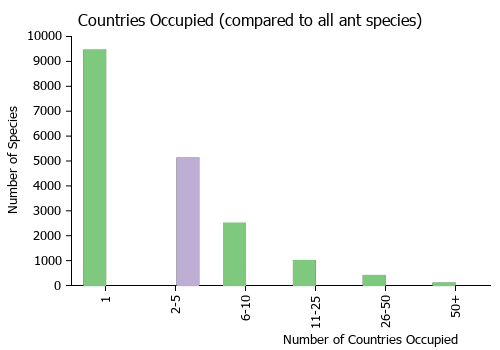
|
Estimated Abundance
| Relative abundance based on number of AntMaps records per species (this species within the purple bar). Fewer records (to the left) indicates a less abundant/encountered species while more records (to the right) indicates more abundant/encountered species. |

|
Biology
Mackay and Mackay (2002), in New Mexico: Camponotus hyatti appears to be limited to areas of sagebrush at around 1770 m elevation, where it nests in sagebrush roots (Artemesia spp.).
Nevada, Wheeler and Wheeler (1986) - We have 25 records from 24 localities widely scattered throughout the state: 3,800-8,000 ft. Fifteen records are from the Cool Desert (5 from Sarcobatus Subclimax), 2 are from the Pinyon-Juniper Biome, and 1 from the Coniferous Forest. Five nests were recorded from rotten wood.
Flight Period
| X | X | X | |||||||||
| Jan | Feb | Mar | Apr | May | Jun | Jul | Aug | Sep | Oct | Nov | Dec |
Source: antkeeping.info.
- Check details at Worldwide Ant Nuptial Flights Data, AntNupTracker and AntKeeping.
- Explore: Show all Flight Month data or Search these data. See also a list of all data tables or learn how data is managed.
Castes
Polymorphic workers include majors, medias and minors.
Worker
     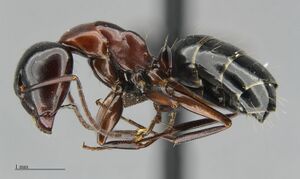  File:IMG File:IMG
| |
| . | Owned by Museum of Comparative Zoology. |
Images from AntWeb
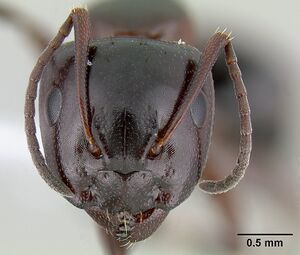   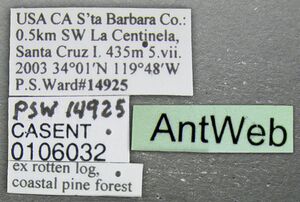
| |
| Worker. Specimen code casent0106032. Photographer Michael Branstetter, uploaded by California Academy of Sciences. | Owned by UCDC, Davis, CA, USA. |
   
| |
| Syntype of Camponotus sayi bicolor. Worker. Specimen code castype00600. Photographer April Nobile, uploaded by California Academy of Sciences. | Owned by CAS, San Francisco, CA, USA. |
   
| |
| Syntype of Camponotus sayi bicolor. Worker. Specimen code castype00601. Photographer April Nobile, uploaded by California Academy of Sciences. | Owned by CAS, San Francisco, CA, USA. |
Queen
Images from AntWeb
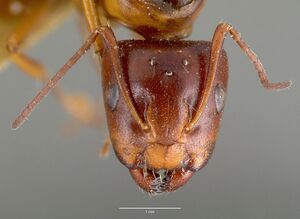   
| |
| Syntype of Camponotus sayi bicolor. Queen (alate/dealate). Specimen code castype00599. Photographer April Nobile, uploaded by California Academy of Sciences. | Owned by CAS, San Francisco, CA, USA. |
 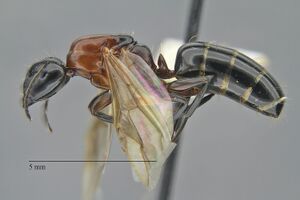  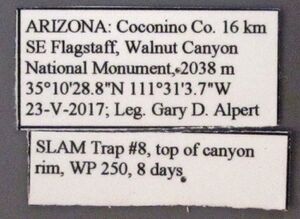
| |
| . | |
Male
Images from AntWeb
   
| |
| Syntype of Camponotus sayi bicolor. Male (alate). Specimen code castype00598. Photographer April Nobile, uploaded by California Academy of Sciences. | Owned by CAS, San Francisco, CA, USA. |
Nomenclature
The following information is derived from Barry Bolton's Online Catalogue of the Ants of the World.
- hyatti. Camponotus hyatti Emery, 1893i: 680, pl. 22, figs. 25, 26 (s.w.) U.S.A. (California).
- Combination in C. (Camponotus): Forel, 1914a: 266;
- combination in C. (Myrmentoma): Emery, 1920b: 257; Mackay & Mackay, 2018: 22.
- Status as species: Emery, 1896d: 373 (in list); Wheeler, W.M. 1910d: 345; Wheeler, W.M. 1910g: 572; Forel, 1914a: 266; Wheeler, W.M. 1917a: 557; Emery, 1925b: 119; Cole, 1936a: 39; Creighton, 1950a: 387; Smith, M.R. 1951a: 845; Cole, 1966: 19 (in key); Smith, D.R. 1979: 1432; Snelling, R.R. & George, 1979: 185; Allred, 1982: 455; Wheeler, G.C. & Wheeler, J. 1986g: 61; Mackay, Lowrie, et al. 1988: 105; Snelling, R.R. 1988: 69; Bolton, 1995b: 104; Mackay & Mackay, 2002: 292; Hansen & Klotz, 2005: 91; Ward, 2005: 63.
- Senior synonym of californica: Snelling, R.R. 1988: 69; Bolton, 1995b: 104; Mackay & Mackay, 2018: 22.
- bicolor. Camponotus sayi subsp. bicolor Pergande, 1894: 161 (s.w.q.m.) MEXICO (Baja California).
- [Junior secondary homonym of Formica bicolor Latreille, 1798, 43.]
- Subspecies of sayi: Emery, 1895c: 337; Emery, 1896d: 373 (in list); Forel, 1899c: 158.
- Replacement name: Camponotus (Myrmentoma) sayi subsp. californica Emery, 1925b: 118.
- californica. Camponotus (Myrmentoma) sayi subsp. californica Emery, 1925b: 118.
- Replacement name for Camponotus sayi subsp. bicolor Pergande, 1894: 161. [Junior secondary homonym of Formica bicolor Latreille, 1798: 43.]
- Status as species: McArthur, 2012: 200 (error)
- Junior synonym of sayi: Snelling, R.R. 1968b: 355; Smith, D.R. 1979: 1432; Snelling, R.R. & George, 1979: 190.
- Junior synonym of hyatti: Snelling, R.R. 1988: 69; Bolton, 1995b: 90; Mackay & Mackay, 2018: 22.
Unless otherwise noted the text for the remainder of this section is reported from the publication that includes the original description.
Description
Worker
Wheeler (1910) translation of Emery description - Closely allied to C. marginatus (C. fallax), but the head with more shining and more nearly parallel sides; posterior corners less rounded, mandibles shining; thorax impressed in the region of the meso-epinotal suture; epinotum with the convex base and concave declivity meeting to form an obtuse angle. Piceous black; mouth, pronotum and legs more or less ferrugi, nous or red. Abdomen black. Length, 3.5--6.5 mm.
Head of the worker maxima, 1.9 x 1.8 mm.; scape, 1.2 mm.; hind femur, 1.7 mm.; thorax, 2 x 1.3 mm.
In habitus very similar to Camponotus marginatus; body more thickset. The head in the worker major has more nearly parallel, less convex sides, more concavely excised posterior border, more prominent anterior and posterior corners, the latter being less broadly rounded. In the worker minor the head is somewhat broader than in the minor worker of the same size. the anterior corners somewhat more rounded. The sculpture is very similar to that of the typical marginatus, but much more superficial; the impressed punctures much shallower, scarcely visible on the clypeus, smaller on the cheeks; the integument is therefore much more shining. The mandibles are less prominent than in marginatus, with more convex outer borders, also 5-toothed, shining, sparsely punctate. The clypeus also has a very short, rounded lobe, with anterior border strongly emarginate in the middle; fiat in the worker major, bluntly roof-shaped in the minor. The lobe is less conspicuous in the large worker, owing to the more prominent anterior corners of the head. The thorax is .proportionally broader than in marginatus, in profile distinctly constricted between the meso- and epinotum; the somewhat convex basal and the distinctly concave declivous surface form together a rounded angle. Seen from above, the pronotum is especially broad and rounded on the sides; the mesonotum is strongly narrowed posteriorly to the mesoepinotal suture, where the thorax is narrowest; the sides of the epinotum are nearly parallel. The petiolar scale is somewhat broader and thinner than in marginatus, its upper margin broadly arched and rather sharp. The sculpture of the thorax and gaster are as in marginatus, and the same is true of the pilosity of the whole body.
The color is variable; usually pitch black; mouth, gula and tibiae somewhat reddish; prothorax, coxae, femora and tarsi light red; gaster black, with reddish yellow margins to the segments. Often, especially in minor workers, the pale color is more extensive and the whole insect may be ferruginous red with brownish black gaster.
Type Material
From San Jacinto, California; collected by Mr. Ed. Hyatt; received from Mr. Pergande.
References
- Alatorre-Bracamontes, C.E., Vásquez-Bolaños, M. 2010. Lista comentada de las hormigas (Hymenoptera: Formicidae) del norte de México. Dugesiana 17(1): 9-36.
- Emery, C. 1893k. Beiträge zur Kenntniss der nordamerikanischen Ameisenfauna. Zool. Jahrb. Abt. Syst. Geogr. Biol. Tiere 7: 633-682 (page 680, pl. 22, figs. 25, 26 soldier, worker described)
- Emery, C. 1920b. Le genre Camponotus Mayr. Nouvel essai de la subdivision en sous-genres. Rev. Zool. Afr. (Bruss.) 8: 229-260 (page 257, Combination in C. (Myrmentoma))
- Forel, A. 1914a. Le genre Camponotus Mayr et les genres voisins. Rev. Suisse Zool. 22: 257-276 (page 266, Combination in C. (Camponotus))
- Mackay, W. P. and E. Mackay. 2002. The ants of New Mexico (Hymenoptera: Formicidae). Edwin Mellen Press, Lewiston, NY.
- Oswalt, D.A. 2007. Nesting and foraging characteristics of the black carpenter ant Camponotus pennsylvanicus DeGeer (Hymenoptera: Formicidae). Ph.D. thesis, Clemson University.
- Snelling, R. R. 1988. Taxonomic notes on Nearctic species of Camponotus, subgenus Myrmentoma (Hymenoptera: Formicidae). Pp. 55-78 in: Trager, J. C. (ed.) Advances in myrmecology. Leiden: E. J. Brill, xxvii + 551 pp. (page 69, Senior synonym of californica)
- Snelling, R.R. 2000. A review of the Camponotus montivagus complex (Hymenoptera: Formicidae). Sociobiology 36: 599-611.
- Wheeler, G. C. and J. Wheeler. 1986. The ants of Nevada. Natural History Museum of Los Angeles County, Los Angeles.
References based on Global Ant Biodiversity Informatics
- Allred D. M. 1982. Ants of Utah. The Great Basin Naturalist 42: 415-511.
- Allred, D.M. 1982. The ants of Utah. Great Basin Naturalist 42:415-511.
- Cole, A.C. 1936. An annotated list of the ants of Idaho (Hymenoptera; Formicidae). Canadian Entomologist 68(2):34-39
- Cover S. P., and R. A. Johnson. 20011. Checklist of Arizona Ants. Downloaded on January 7th at http://www.asu.edu/clas/sirgtools/AZants-2011%20updatev2.pdf
- Dattilo W. et al. 2019. MEXICO ANTS: incidence and abundance along the Nearctic-Neotropical interface. Ecology https://doi.org/10.1002/ecy.2944
- Des Lauriers J., and D. Ikeda. 2017. The ants (Hymenoptera: Formicidae) of the San Gabriel Mountains of Southern California, USA with an annotated list. In: Reynolds R. E. (Ed.) Desert Studies Symposium. California State University Desert Studies Consortium, 342 pp. Pages 264-277.
- Emery C. 1886. Saggio di un catalogo sistematico dei generi Camponotus, Polyrhachis e affini. Memorie della Reale Accademia delle Scienze dell'Istituto di Bologna 5: 363-382
- Fisher B. L. 1997. A comparison of ant assemblages (Hymenoptera, Formicidae) on serpentine and non-serpentine soils in northern California. Insectes Sociaux 44: 23-33
- Johnson R. Personnal Database. Accessed on February 5th 2014 at http://www.asu.edu/clas/sirgtools/resources.htm
- Johnson, R.A. and P.S. Ward. 2002. Biogeography and endemism of ants (Hymenoptera: Formicidae) in Baja California, Mexico: a first overview. Journal of Biogeography 29:10091026/
- La Rivers I. 1968. A first listing of the ants of Nevada. Biological Society of Nevada, Occasional Papers 17: 1-12.
- Longino, J.T. 2010. Personal Communication. Longino Collection Database
- Mackay, W., D. Lowrie, A. Fisher, E. Mackay, F. Barnes and D. Lowrie. 1988. The ants of Los Alamos County, New Mexico (Hymenoptera: Formicidae). pages 79-131 in J.C. Trager, editor, Advances in Myrmecololgy.
- Mackay W. P. and Mackay, E. E. 2002. The ants of New Mexico (Hymenoptera: Formicidae). Lewiston, New York: Edwin Mellen Press, 400 pp.
- Snelling, R.R. 1988. Taxonomic notes on Nearctic species of Camponotus, subgenus Myrmentoma (Hymenoptera: Formicidae). pages 55-XX in J. Trager, editor, Advances in Myrmecology
- Vásquez-Bolaños M. 2011. Lista de especies de hormigas (Hymenoptera: Formicidae) para México. Dugesiana 18: 95-133
- Wetterer, J. K.; Ward, P. S.; Wetterer, A. L.; Longino, J. T.; Trager, J. C.; Miller, S. E. 2000. Ants (Hymenoptera: Formicidae) of Santa Cruz Island, California. Bulletin of the Southern California Academy of Sciences 99:25-31.
- Wetterer, J.K., P.S. Ward, A.L. Wetterer, J.T. Longino, J.C. Trager and S.E. Miller. 2000. Ants (Hymenoptera:Formicidae) of Santa Cruz Island, California. Bulletin of the Southern California Academy of Science 99(1):25-31.
- Wheeler G. C., and J. Wheeler. 1986. The ants of Nevada. Los Angeles: Natural History Museum of Los Angeles County, vii + 138 pp.
- Wheeler, William Morton. 1904. Ants From Catalina Island, California. Bulletin of the American Museum of Natural History. XX. 269-271.
- Wheeler, William Morton. 1904. Ants from Catalina Island, California in Bulletin of the American Museum of Natural History. 20:269-271.




